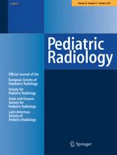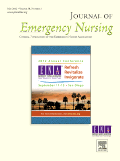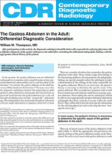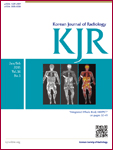
Emergency Radiology
Scope & Guideline
Shaping the Future of Emergency Radiology
Introduction
Aims and Scopes
- Emergency Imaging Techniques:
The journal emphasizes the development and evaluation of various imaging modalities such as CT, MRI, and ultrasound in emergency situations, focusing on their effectiveness in diagnosing acute conditions. - Artificial Intelligence in Radiology:
A significant focus is placed on the integration of AI technologies in emergency radiology, exploring their potential to improve diagnostic accuracy and workflow efficiency. - Trauma and Acute Care Radiology:
The journal publishes research related to trauma imaging, including studies on the management of traumatic injuries and the role of imaging in acute care settings. - Prognostic Factors and Outcomes:
Many papers address prognostic indicators derived from imaging findings that assist in predicting patient outcomes and directing clinical management. - Quality Improvement and Utilization Studies:
Research on the appropriateness of imaging studies, including overutilization and underutilization of certain modalities in emergency departments, is a recurring theme. - Pediatric Emergency Radiology:
The journal also covers pediatric cases, focusing on the unique challenges and imaging considerations in diagnosing emergencies in children.
Trending and Emerging
- Integration of AI and Machine Learning:
There is a notable increase in research investigating the application of AI and machine learning in emergency radiology, aimed at enhancing diagnostic processes and workflow efficiency. - Telemedicine and Remote Imaging:
The rise of telemedicine has led to a growing interest in remote imaging techniques, particularly in emergency situations where rapid decision-making is critical. - Post-COVID-19 Imaging Paradigms:
Research focusing on the impact of COVID-19 on imaging practices and the resultant changes in protocols, including the evaluation of pulmonary complications, has surged. - 3D Imaging Techniques:
Emerging interest in 3D rendering and cinematic imaging for better visualization of complex anatomical structures and pathologies in emergencies is becoming more prominent. - Focus on Socio-Demographic Factors in Imaging:
There is an increasing trend towards studying the socio-demographic factors influencing imaging utilization and outcomes, reflecting a broader understanding of healthcare disparities.
Declining or Waning
- Traditional Radiological Techniques:
There appears to be a waning interest in traditional imaging techniques, such as plain radiography for certain emergency conditions, as advanced modalities like CT and MRI become more favored. - Non-Emergency Radiology Topics:
Papers focusing on non-emergency or elective imaging procedures have become less frequent, indicating a shift towards urgent and acute care radiology. - Unconventional Imaging in Non-Trauma Cases:
The exploration of unconventional imaging techniques for non-trauma scenarios has diminished, possibly overshadowed by the increasing focus on more standardized emergency protocols.
Similar Journals

EUROPEAN JOURNAL OF RADIOLOGY
Transforming Patient Care Through Radiological ResearchThe European Journal of Radiology, published by Elsevier Ireland Ltd, is a premier peer-reviewed journal in the fields of radiology, nuclear medicine, and imaging. Established in 1981, it has carved a significant niche within the academic community, showcasing innovative research that enhances medical imaging practices and improves patient care. With an impressive ranking in the Q1 category for both Medicine (miscellaneous) and Radiology, Nuclear Medicine, and Imaging in 2023, the journal is recognized globally for its commitment to advancing scientific knowledge and improving imaging methodologies. The journal's Scopus ranking of #60/333, placing it in the 82nd percentile, underlines its reputation for high-quality research and scholarly contributions. While traditionally a subscription-based journal, it continually evolves to meet the demands of the academic landscape, aiming to bridge the gap between research and clinical practice. Researchers, healthcare professionals, and students alike can benefit from exploring its extensive archives and current publications, which are curated to foster education and innovation in the medical imaging domain.

Journal of the Belgian Society of Radiology
Pioneering Innovations in Imaging and Nuclear MedicineThe Journal of the Belgian Society of Radiology, published by UBIQUITY PRESS LTD, is a pivotal resource in the field of radiology, nuclear medicine, and imaging. With an ISSN of 2514-8281 and E-ISSN of 2514-8281, this open access journal has been dedicated to fostering the dissemination of high-quality research since its establishment in 2010. Distributed from the United Kingdom, it offers a platform for innovative studies, case reports, and reviews that contribute to the advancement of radiological sciences. Despite its current Q4 category ranking within Scopus, the journal plays a critical role in sharing essential findings with a community of over 1,200 professionals and students eager to stay abreast of emerging trends and technological advancements in imaging. By enabling unrestricted access to its publications, the journal encourages collaborative research and knowledge exchange that transcends geographic boundaries, solidifying its importance for both established researchers and emerging scholars in the discipline.

PEDIATRIC RADIOLOGY
Enhancing diagnosis and treatment in pediatric medicine.Pediatric Radiology is a leading journal published by Springer that provides a crucial platform for the dissemination of research in the fields of pediatrics, perinatology, and radiology. Since its inception in 1973, the journal has continually contributed to the advancement of medical imaging techniques and their application in diagnosing and treating pediatric conditions. With its impact factor reflecting a Q2 ranking in both Pediatrics and Radiology categories as of 2023, Pediatric Radiology is highly regarded in scholarly circles, aiding researchers, clinicians, and students to stay at the forefront of innovations and findings in the field. Although the journal does not offer open access, it continues to be an essential resource for evidence-based information that enhances clinical practice and improves health outcomes for children globally. The journal's reach is further established through its solid Scopus rankings, indicating its relevance and influence in the global medical community.

Journal of Emergency Nursing
Elevating Standards in Emergency Nursing ExcellenceJournal of Emergency Nursing, published by Elsevier Science Inc, serves as a premier platform for advancing the field of emergency nursing. Since its inception in 1975, this peer-reviewed journal has established itself as a vital resource for researchers, practitioners, and educators alike, with a notable impact factor and current ranking of #8 out of 32 in the Emergency Nursing category, placing it in the 76th percentile. The journal's commitment to the dissemination of high-quality evidence, innovative practices, and essential insights makes it an indispensable tool for those seeking to excel in acute care settings. Although not open access, the Journal of Emergency Nursing is dedicated to fostering knowledge and improving patient outcomes through robust research and comprehensive reviews, aligning closely with its mission to enhance emergency nursing practices and education through every issue until 2024 and beyond. For professionals and students keen on staying at the forefront of emergency care advancements, this journal provides a wealth of knowledge and resources, reflecting the critical issues and developments shaping the future of healthcare.

Contemporary Diagnostic Radiology
Pioneering Research in Contemporary RadiologyContemporary Diagnostic Radiology is a pivotal journal in the field of medical imaging and radiology, published by Lippincott Williams & Wilkins. With an ISSN of 0149-9009 and an E-ISSN of 1938-1395, this journal serves as an essential platform for disseminating high-quality research and advances in diagnostic radiology and related disciplines. While it is categorized in the lower quartiles (Q4) for its performance in the 2023 rankings in both Neurology, Radiology, Nuclear Medicine and Imaging, and Surgery, its focus on emerging technologies and methodologies in imaging continues to provide valuable insights for practitioners and researchers alike. The journal’s scope includes innovative diagnostic tools, imaging techniques, and case studies, fostering collaboration and knowledge sharing in the medical community. Although it does not offer open access options, its commitment to contributing to the ongoing dialogue in clinical imaging is undisputed, making it an essential resource for professionals seeking to stay abreast of current trends and research in the rapidly evolving landscape of diagnostic radiology.

CANADIAN ASSOCIATION OF RADIOLOGISTS JOURNAL-JOURNAL DE L ASSOCIATION CANADIENNE DES RADIOLOGISTES
Shaping the Future: Essential Contributions from Radiology ExpertsCanadian Association of Radiologists Journal - Journal de l'Association Canadienne des Radiologistes, published by SAGE Publications Inc, stands as a vital resource in the realms of Radiology and Medicine. With an ISSN of 0846-5371 and an E-ISSN of 1488-2361, this esteemed journal offers insightful research articles and reviews that contribute to the advancement and practice of radiology, benefiting both seasoned professionals and emerging scholars. Holding a commendable Q2 ranking in both the fields of Medicine (miscellaneous) and Radiology, Nuclear Medicine and Imaging, the journal is recognized for its impactful publications, positioning its content within the top 40% of global research outputs. Since its inception in 1973 and continuing through to 2024, it has consistently provided a platform for cutting-edge research and clinical innovations, facilitating knowledge transfer among practitioners and educators. The journal’s significant influence is evidenced by its Scopus rank of #67 out of 333 in its category, placing it in the 80th percentile of academic excellence. Although it does not offer open access, its contributions are critical for advancing the field, making it essential reading for all those invested in the evolution of radiological sciences.

Imaging
Illuminating Innovations in Imaging TechniquesImaging, published by AKADEMIAI KIADO ZRT, is an esteemed open-access journal dedicated to the field of medical imaging, established in 2020. With an E-ISSN of 2732-0960 and based in Budapest, Hungary, this journal provides a vital platform for the dissemination of cutting-edge research and advancements in imaging techniques, especially in the realms of radiology, nuclear medicine, and ultrasound technology. While currently positioned in the Q4 category across multiple medical specialties, the journal continues to strive for improvements in visibility and impact, contributing to the evolving discourse in medical imaging. The journal aims to facilitate an inclusive and collaborative environment for researchers, professionals, and students, inviting them to share their findings and insights to enhance the field's development. With open-access availability since its inception, Imaging ensures free and easy access to its content, fostering a greater understanding and appreciation of innovative imaging practices worldwide.

Turkish Journal of Emergency Medicine
Empowering emergency medicine with open access knowledge.Turkish Journal of Emergency Medicine, published by Wolters Kluwer Medknow Publications, is a premier Open Access journal dedicated to advancing the field of emergency and critical care medicine. With an ISSN of 2452-2473, the journal has established a global readership since its inception in 2014, ensuring that groundbreaking research is accessible to all. Situated in Turkey, this journal has been recognized for its significant contributions to the medical community, currently holding a Q2 rank in both Critical Care and Intensive Care Medicine and Emergency Medicine as of 2023. The journal aims to publish insightful articles that cover a wide range of topics within its scope, making it a crucial resource for researchers, healthcare professionals, and students who are committed to improving patient outcomes in emergency settings. Accessible online, it fosters collaboration and knowledge sharing across borders, positioning itself as an essential platform for the latest advancements in this critical discipline.

Tomography
Advancing medical imaging through innovative research.Tomography is an esteemed peer-reviewed journal published by MDPI, focusing on a broad spectrum of topics related to medical imaging and diagnostics. Launched in 2015, this Open Access journal serves as a vital platform for researchers, professionals, and students in the fields of medicine, radiology, nuclear medicine, and imaging. With an impressive impact factor reflecting its relevance, the journal has achieved a quartile ranking of Q2 in both Medicine (Miscellaneous) and Radiology, Nuclear Medicine, and Imaging as of 2023. Renowned for disseminating high-quality research, Tomography welcomes original research articles, reviews, and technical notes, fostering innovation and collaboration within the scientific community. Housed in Basel, Switzerland, the journal aims to bridge the gap between fundamental research and clinical application, appealing to a diverse readership eager to advance the field of medical imaging.

KOREAN JOURNAL OF RADIOLOGY
Elevating Standards in Radiological ResearchKorean Journal of Radiology (ISSN: 1229-6929, E-ISSN: 2005-8330), published by the Korean Society of Radiology, stands as a leading international platform for the dissemination of high-quality research and advancements in the fields of radiology, nuclear medicine, and imaging. With a remarkable impact factor and ranked in the Q1 quadrant in its category, this journal showcases cutting-edge studies, clinical investigations, and comprehensive reviews that significantly contribute to the understanding and practice of medical imaging. Researchers, clinicians, and students alike will find the journal an invaluable resource, featuring innovative methodologies, case studies, and essential updates in imaging technology. Since its inception in 2000 and continuing through 2024, the Korean Journal of Radiology remains dedicated to promoting excellence and fostering collaborative research within the global radiology community, underscoring the importance of imaging in modern medicine.